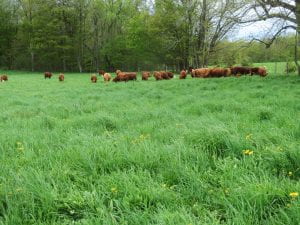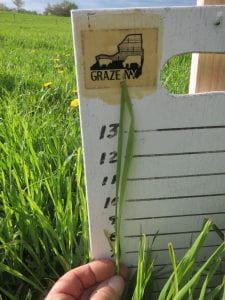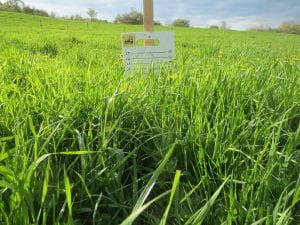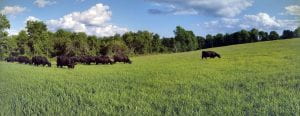Project Objective:
Graziers who participate will fine tune their grazing skills to help improve pasture output by learning how weather conditions (rainfall, temperature) interact with management decisions (residue height, rest) to affect regrowth in their pastures. More information on the project can be found below this week’s report! Reports, resources and more information can also be found in the open Box folder here Pasture Regrowth Monitoring Project
This Week’s Report:
Pasture Regrowth Report 5.14.21 <– click there to view the report!
This will be the only blog post during the grazing season – future reports will come via a direct email to program participants. Email Betsy at bjh246@cornell.edu to be included on the list!
The Grass Whisperer’s Pasture Pontification – 5/14/2021
Last week was highlighted by over 2 inches of rain, a smattering of snow and in many locations, several mornings of frost. Those that are trying to graze are experiencing slower pasture growth and the fear of pugging. All our farmer contributors have animals out with one grass-fed dairy completing a 23 day rotation. I’m still confident when the temperatures rise and the sun shines, growth will explode, provided the swards have the photosynthesis capacity (leaf area) to accumulate energy. Many have said this growth measuring is a positive nudge to look closer at their pastures once a week. One farmer said, “I needed this pressure and the phone call to up my management game”. One thing I’ve noticed is slower growth as the grass plants reach their 4 to 5 leaf stage, however the health of the understory forage is quite dense. This plays nicely with a planned recovery time of 20-25 days coming up shortly and optimal animal performance. More forage-More Money. Thanks GW
Betsy’s Take on the Report:
On average, locations reporting information gained about 96 Growing Degree Days (Base 32) in the last week. I’m choosing to track temperature in this way so we can see relative gains in heat through the growing season, and Base 32 matches well with grass’s growing habits early in the spring. Minimum location for gaining GDD was 68 GDD in Brookfield, and maximum gain was 131 GDD in Hudson. Median gain was 101 GDD for the past week, and each location in the report shows their gain over the last week, as well as Cumulative GDD since March 1. The cumulative numbers also match up with locations, with Hudson having 1032 GDD and Brookfield only showing 618 GDD.
The cooler weather this past week slowed growth down, with the average growth for locations being less than a half an inch per day. Warmer weather this week ought to speed that up, now that we have adequate moisture.
Sam Corcoran of the University of Massachusetts will be chiming in throughout the grazing season – check out the resources folder on Box at Pasture Regrowth Monitoring Project for some videos on measuring regrowth and other resources as we add them!
Make sure you call in to the Monthly Grazing Call next Friday May 21st at 10 AM. Info on that is below!
Target Audience:
Graziers throughout NY state utilizing rotational grazing strategies. Graziers can enroll throughout the summer and start tracking grass regrowth at any point!
Program Plan:
Participants will identify 1-2 pastures to record weekly measurements of grass height, as well as rainfall amounts for their location. That’s it!
- To enroll, farms should send Betsy or Troy :
- Name, email, phone number
- Location of pasture (GPS coordinates)
- Elevation of pasture
- Nearest town
- What you’re grazing (beef steers, beef cow/calf, dairy heifers, dairy cows, etc)
- Starting height of pasture for that week
- Weekly, farms should report:
- Rainfall for the week (inches)
- Height of pasture (inches)
- Date pasture was grazed or clipped
- If pasture was grazed or clipped, height of residual (inches)
- From these enrollment & weekly measurements, Betsy & Troy will calculate:
- Regrowth rate
- Cumulative GDD using Cornell Climate Smart Farming’s GDD calculator (http://climatesmartfarming.org/tools/csf-growing-degree-day-calculator/)
More Information:
- Graziers should do their measurements on the same day every week, but they can choose to do measurements on any day from Monday to Thursday.
- Measurements can be sent to Betsy/Troy via email, text or phone call by Thursday at NOON each week.
- Betsy & Troy will compile the weekly grazing report, to be sent out on Friday morning each week.
- This will be the only blog post during the grazing season – future reports will come via a direct email to program participants. Email Betsy bjh246@cornell.edu to be included on the list!
Monthly Grazing Calls to Compare Notes:
Once a month during the grazing season, Betsy & Troy will hold an open grazing call for participants to compare notes, to start on Friday, May 21st 10 am
- Topic: Monthly Grazing Call
- Time: May 21, 2021 10:00 AM Eastern Time (US and Canada)
- Join Zoom Meeting https://cornell.zoom.us/j/92037355795
- Meeting ID: 920 3735 5795One tap mobile +16468769923,,92037355795# US (New York)
Participants can join the project and calls at any time during the grazing season. Feel free to forward this notice! The more the merrier!
Collaborators:
Troy Bishopp of the Upper Susquehanna Coalition / Madison County SWCD and Betsy Hicks of the CCE South Central NY Dairy & Field Crops Team. All are invited to participate, regardless of region!





